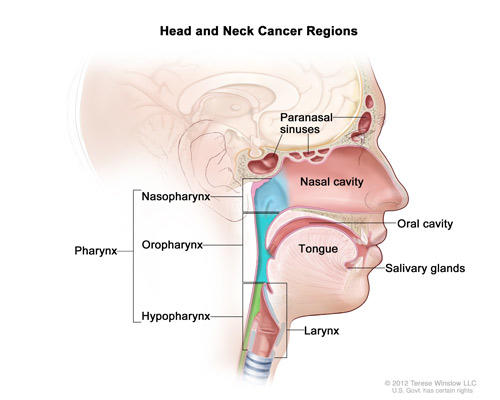Head and Neck Cancer

In Denver and Lone Tree, Colorado
Head and neck cancer refers to tumors that start in or near your throat (pharynx), voice box (larynx), nose, sinuses, or the oral cavity (mouth, tongue, and tonsils). Additionally, tumors may arise from the salivary glands, bone, nerves, and muscles of the area. Squamous cell carcinoma is the most common type of head and neck cancer, and it begins in the cells that line the surfaces of these body parts.
Types of Head and Neck Cancer
There are five main types of head and neck cancer, which include the oral cavity, the pharynx, the larynx, the nasal cavity, and paranasal sinuses, and the salivary glands.
Oral Cavity. This type of cancer affects the lips, tongue, gums, the lining inside the cheeks, the floor (bottom) of the mouth under the tongue, the hard palate (bony top of the mouth), and the small area of the gum behind the wisdom teeth.
Pharynx (throat). This type of cancer affects the nasopharynx (upper part of the pharynx, behind the nose); the oropharynx (middle part of the pharynx including the soft palate and the back portion of the mouth, the base of the tongue, and the tonsils); and the hypopharynx (the lower part of the pharynx).
Larynx (voice box). This type of cancer affects the vocal cords, epiglottis, and arytenoid cartilage.
Paranasal Sinuses and Nasal Cavity. This type of cancer affects the paranasal sinuses that are small hollow spaces in the bones of the head surrounding the nose, and the nasal cavity which is the hollow space inside the nose.
Salivary Glands. This type of cancer affects any of the 3 paired sets of salivary glands, including the parotid (located in the cheeks just in front of the ears), the sublingual and submandibular glands (located below the tongue and jaw bone respectively).
Early Detection of Head And Neck Cancer
Tobacco use is the most preventable cause of these deaths. In the United States, up to 200,000 people die each year from smoking-related illnesses. The good news is that this figure has decreased due to the increasing number of Americans who have quit smoking. The bad news is that some of these smokers switched to smokeless or spit tobacco, assuming it is a safe alternative. This is untrue. By doing so, they are only changing the site of the cancer risk from their lungs to their mouths. While lung cancer cases are decreasing, cancers in the head and neck appear to be increasing, but they are curable if caught early. Fortunately, most head and neck cancers produce early symptoms. You should know the potential warning signs so you can alert your doctor as soon as possible.
Remember—successful treatment of head and neck cancer depends on early detection. Knowing and recognizing its signs can save your life.
Symptoms of Head And Neck Cancer
A lump in the neck. Cancers that begin in the head or neck usually spread to lymph nodes in the neck before they spread elsewhere. A lump in the neck that lasts more than 2 weeks should be seen by one of our ENT physicians as soon as possible. Of course, not all lumps are cancer. But a lump (or lumps) in the neck can be the first sign of cancer of the mouth, throat, voicebox (larynx), thyroid gland, or of certain lymphomas and blood cancers. Such lumps are generally painless and continue to enlarge steadily.
Change in the voice. Most cancers in the larynx cause some changes in voice. Our ENT physicians can examine your vocal cords easily and painlessly. While most voice changes are not caused by cancer, you shouldn’t take chances. If you are hoarse or notice voice changes for more than 2 weeks, see one of our doctors.
Growth in the mouth. Most cancers of the mouth or tongue cause a sore or swelling that doesn’t go away. These may be painless, which can be misleading. Bleeding may occur, but often not until late in the disease. If an ulcer or swelling is accompanied by lumps in the neck, you should be concerned. In addition, any sore or swelling in the mouth that does not go away after a week should be evaluated by one of our ENT physicians. Your doctor can determine if a biopsy (tissue sample test) is needed.
Bringing up blood. This is often caused by something other than cancer. However, tumors in the nose, mouth, throat, or lungs can cause bleeding. If blood appears in your saliva or phlegm for more than a few days, you should see your ENT physician.
Swallowing problems. Cancer of the throat or esophagus (swallowing tube) may make swallowing solid foods—and sometimes liquids—difficult. The food may “stick” at a certain point and then either go through to the stomach or come back up. If you have trouble almost every time you try to swallow something, you should be examined by one of our ENT physicians. Usually, a barium swallow x-ray or an esophagoscopy (direct examination of the swallowing tube with a scope) will be performed to find the cause.
Changes in the skin. The most common head and neck cancer is basal cell cancer of the skin. Fortunately, this is rarely serious if treated early. Basal cell cancers appear most often on sun-exposed areas like the forehead, face, and ears, but can occur almost anywhere on the skin. Basal cell cancer often begins as a small, pale patch that enlarges slowly, producing a central “dimple” and eventually an ulcer. Parts of the ulcer may heal, but the major portion remains ulcerated. Some basal cell cancers show color changes. Other kinds of cancer, including squamous cell cancer and malignant melanoma, also occur on the head and neck. Most squamous cell cancers occur on the lower lip and ear. They may look like basal cell cancers, and if caught early and properly treated, they usually are not dangerous. If there is a sore on the lip, lower face, or ear that does not heal, consult one of our ENT physicians. Malignant melanoma typically produces a blue-black or black discoloration of the skin. However, any mole that changes size, color, or begins to bleed may mean trouble. A black or blue-black spot on the face or neck, particularly if it changes size or shape, should be seen as soon as possible by a dermatologist or ENT physician.
Persistent earache. Constant pain in or around the ear when you swallow can be a sign of infection or tumor growth in the throat. This is particularly serious if it is associated with difficulty in swallowing, hoarseness, or a lump in the neck. These symptoms should be evaluated by an ENT physician.
Other specific symptoms per specific type of head and neck cancer are as follows:
Oral Cavity. Symptoms include red or white patches in your mouth, including your gums and tongue; swelling in your jaw, including swelling that makes false teeth fit badly; and bleeding or pain in your mouth.
Pharynx. Symptoms include trouble breathing or talking; painful swallowing; neck or throat pain that doesn’t go away; earaches, pain, or ringing in your ears that keep coming back; and trouble hearing.
Larynx. Symptoms include painful swallowing; ear pain, and changes in your voice.
Nasal Cavity and Paranasal Sinuses. Symptoms include chronic sinus infections that antibiotics don’t cure; blocked sinuses you can’t clear; nosebleeds; headaches; swelling around the eyes; pain in your upper teeth; and problems with false teeth not fitting anymore.
Salivary Glands. Symptoms include swelling under your chin; swelling around your jawbone; numb or paralyzed facial muscles; and pain in your face, chin, or neck that doesn’t go away.
Risk Factors for Head and Neck Cancer
As many as 90 percent of head and neck cancers arise after prolonged exposure to specific risk factors. At least 75% of head and neck cancers are caused by tobacco (including chewing tobacco and using snuff, not just smoking) and alcohol use. Use of tobacco (cigarettes, cigars, chewing tobacco, or snuff) and alcoholic beverages are the most common cause of cancers of the mouth, throat, voice box, and tongue. In adults who do not smoke or drink, cancer of the throat can occur as a result of infection with the human papillomavirus (HPV). Prolonged exposure to sunlight is linked with cancer of the lip and is also established as a major cause of skin cancer.
Other risk factors may include:
- Breathing in Secondhand Smoke (from cigarettes, cigars, and pipes)
- Epstein-Barr Virus (the virus that causes mono)
- Being a Man
- Being Older Than 40
- Being African-American
- Poor Oral Hygiene (of mouth and teeth)
- Breathing in Asbestos, Wood Dust, Paint, and Chemical Fumes
- Smoking Pot
- Having a Deficiency in Vitamin A or B
- Acid Reflux
- Having a Weak Immune System
If you drink too much and smoke, you double your risk of getting head and neck cancer.
What you should do. All of the symptoms and signs described here can occur with no cancer present. In fact, many times complaints of this type are due to some other condition. But you can’t tell without an examination. So if they do occur, please request an appointment with one of our doctors to be sure.
Remember – when found early, most cancers in the head and neck can be cured with few side effects. Cure rates for these cancers could be greatly improved if people would seek medical advice as soon as possible. Play it safe. If you detect warning signs of head and neck cancer, see one of our doctors immediately. And practice health habits that help prevent these diseases.
Diagnosing Head and Neck Cancer
Ideally, you should have yearly exams where your doctor examines your neck for any lumps and examines the inside of your mouth, nose, and throat for any signs of cancer, especially if you smoke and drink in excess. Any mass that is worrisome should be evaluated by a physician who is familiar with head and neck cancer. Typically, imaging studies, lab tests (e.g., blood test, pee test), and a biopsy will need to be done prior to determining the appropriate course of treatment. Your doctor may also order a few other tests including an HPV test, or an endoscopy (a scope used to look at the inside of your head and neck with a tube that goes in through your nose and down your throat).
If you are diagnosed with head and neck cancer, your doctor will figure out what stage of the disease you may have and if it has spread to any other parts of your body. These results, again, will help determine the appropriate course of treatment.
Treatment Options for Head and Neck Cancer
Because there are a wide variety of tumors that can arise in the head and neck, treatment is generally tailored to both the specific type of tumor and the location of that tumor. Other factors of consideration include the stage of the disease, your age, your general health, and if you have HPV.
Treatment options may include surgery, radiation therapy, chemotherapy, targeted therapy, immunotherapy–or some combination of these treatments.
Surgery. Your doctor may zap cancer with a laser or remove the tumor and some of the surrounding healthy tissue. If cancer has spread, your doctor may take out some of the small glands called lymph nodes in your neck.
Side effects of surgery may include losing your voice, hearing loss, trouble chewing or swallowing, and swelling of the mouth or throat.
Radiation Therapy. X-rays or other energy particles are used to kill the cancer cells.
Side effects of radiation therapy include pain or trouble swallowing, changes in your voice, loss of appetite, red or irritated skin, thick spit, feeling sick to your stomach, being tired, sore throat, and sore in your mouth.
Chemotherapy. Medication is administered to stop the cancer cells from growing and dividing.
Side effects of chemotherapy include fatigue, infection, nausea, hair loss, loss of appetite, and diarrhea.
Targeted Therapy. Medication is administered to work on the genes, proteins, and other parts of the cancer cells.
Side effects of targeted therapy depend on the type of medication used but may include problems with your skin, hair, nails or eyes.
Immunotherapy. This treatment uses parts of your immune system to help fight cancer, which can be done in one of two ways. Your doctor can either stimulate your immune system to attack cancer cells or give you man-made proteins to strengthen your immune system.
Contact Us
If you are experiencing symptoms and want an evaluation for head and neck cancer, please contact Integrated ENT at (303) 706-1616 to schedule an appointment. You may also request an appointment online.









